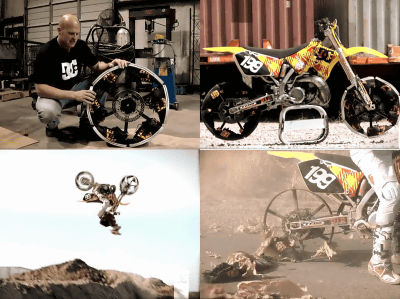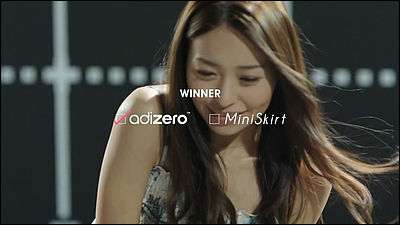How is Nike's Vapor Fly, a shoe that swept the land world, overwhelmed others?

Twenty-one teams and 210 runners participated in the Hakone Ekiden in 2020, but more than 80% were wearing Nike's thick bottom running shoes `` Viper fly '' series, and
Nike VaporFly introduces the latest VaporFly Next%. . Nike.com JP
https://www.nike.com/jp/running/vaporfly
The Nike Vapor Fly Series is a running shoe with a thick sole. Not only is it very light, but the thick sole provides high resilience, creating a light and smooth ride. A carbon fiber plate is embedded in the thick sole, which gives high elasticity and seems to support running.

Get the latest model of the vapor fly series `` Nike Zoom X Vapor Fly Next% '', a movie that tries to unravel the secret while actually wearing and running, jumping and breaking apart is also released I am.
At the time of writing, the video was posted by a former athlete, Nick Simmons, who is working as a YouTuber. An athlete who specializes in the medium distances of 800 meters and 1500 meters, he has been the champion at the US championship at 800 meters six times and has twice competed in the Olympics.
Simmons purchases 'Nike Zoom X Vapor Fly Next%', actually wears and tests it, and finally breaks it apart and explores its secrets, the contents of this movie.
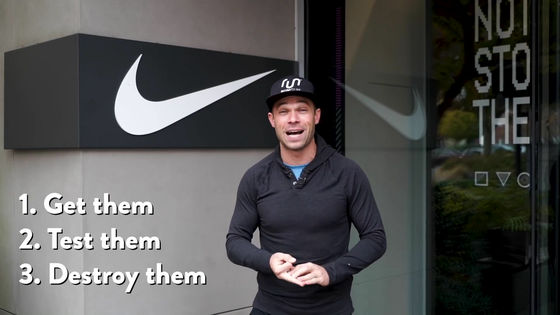
First, purchase Nike Zoom X Vapor Fly Next%. Simmons never heard of the VaporFly series, so he asked the clerk directly at a Nike store to get “Nike Zoom X VaporFly Next%”.
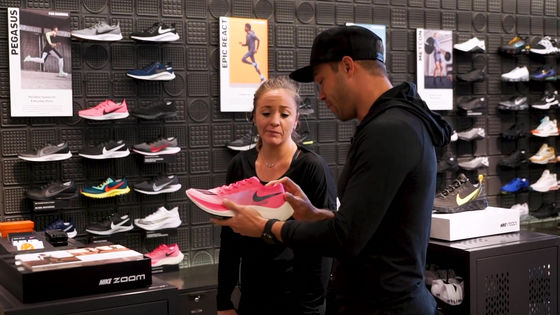
Next, I will actually run with 'Nike Zoom X Vapor Fly Next%'. Simmons seems to have completed the Honolulu marathon in about 3 hours, and conducted a test to actually run on the treadmill at the same speed as the average pace at that time. The running distance is set to just one mile (about 1.6 km), as running a full marathon takes too much time and effort.
As a straightforward impression of actually wearing the 'Nike Zoom X Vapor Fly Next%', Simmons says, 'It has a high cushioning property and is very light!'
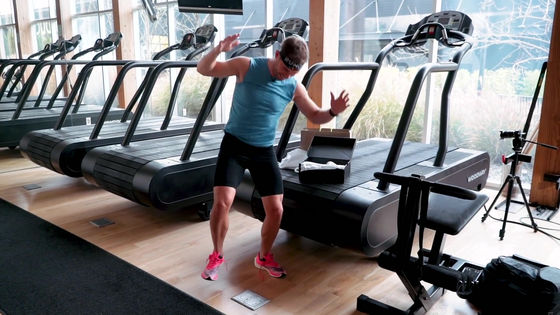
For comparison, French shoe maker Hoka One One 's ' CLIFTON 4 ', which is a thick running shoe, also runs at the same distance and at the same pace.

The running distance and the heart rate information are displayed together and the running starts. In addition, Simmons said that he ran a second time on the second run because he ran with CLIFTON 4 first, then ran with 'Nike Zoom X Vapor Fly Next%'. Therefore, the heart rate at the start of running is slightly higher when wearing 'Nike Zoom X Vapor Fly Next%'.
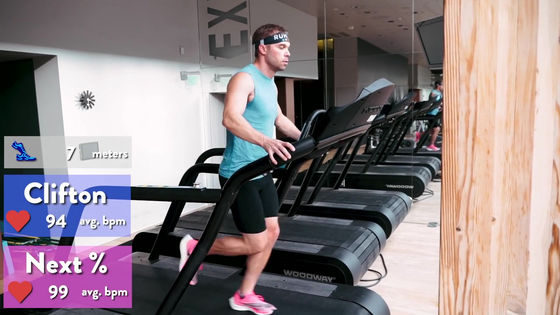
However, when the mileage exceeds 200 meters, the heart rate is higher when wearing CLIFTON 4.

Slow motion shot of the moment the shoes land on the ground. At the moment of landing, you can clearly see how the sole part of CLIFTON 4 sinks, and you can see that these shoes are also thick soles and have excellent cushioning.
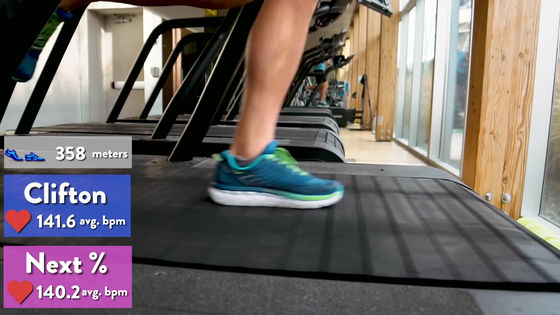
However, you can see that 'Nike Zoom X Vapor Fly Next%' has even better cushioning. Not only the sole sinks at the moment of landing, but also the whole body bouncing enough to imitate the sound of 'Poyon' can be confirmed as slow motion.
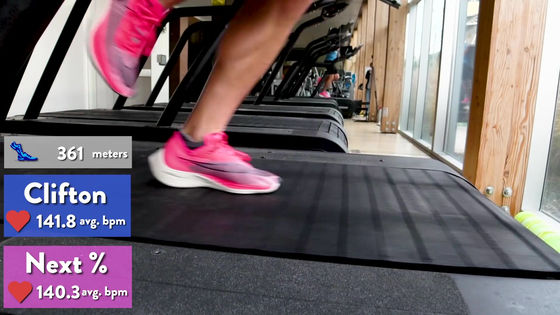
Even after running about 1500 meters, the heart rate was higher when wearing CLIFTON 4. Almost every journey, the heart rate was a few

Assuming that the difference in heart rate of 2 BPM per mile lasts for a full marathon (42.195 km = 26 miles 385 yards), although it was only a trial run of one mile, `` It may be a very big advantage '' And Simmons. He also said that he actually ran, 'I have to feel the mechanical benefits.'

Next, wearing two shoes and measuring the vertical jump record. Measure the record three times with each shoe. At first I jump on wearing CLIFTON 4.
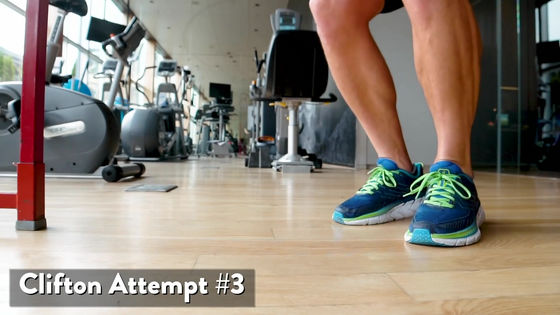
The highest record in three measurements was '22 inches (55.88 cm)'.
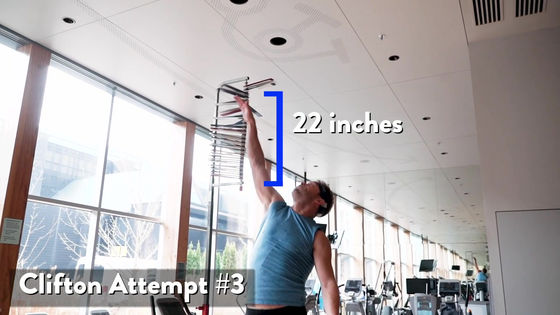
Next, the vertical jump was recorded when 'Nike Zoom X Vapor Fly Next%' was worn.
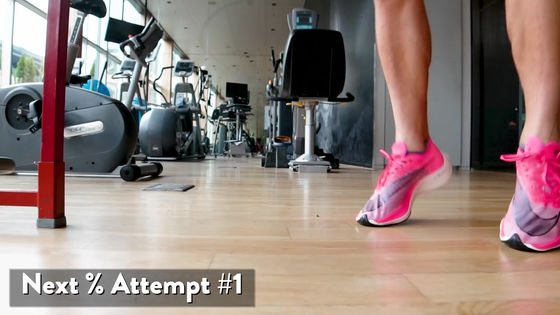
I recorded '22 inches' in the first jump and hit '24 inches (60.96cm)' in the second jump.
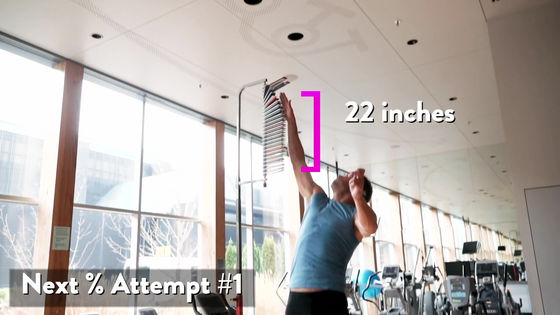
Next, we will disassemble “Nike Zoom X Vapor Fly Next%” based on Nike's patent application. First of all, it is a string part, but it seems to be a very ordinary string.
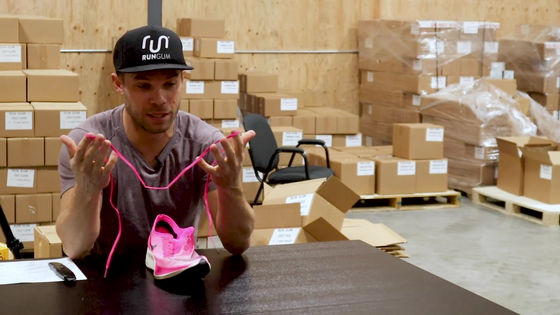
Next, the upper material (pink) that wraps the entire foot. The upper material seems to be extremely durable, but there is no feature that improves the wearer's running here.
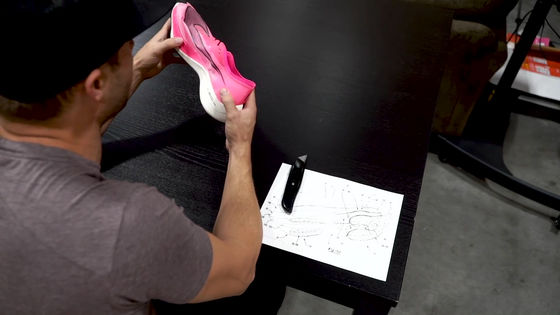
Cut the upper material with a cutter.
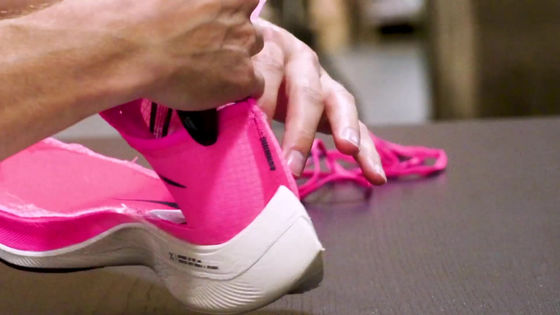
The heel has cushioned pads that allow the entire shoe to fit and secure to the foot.
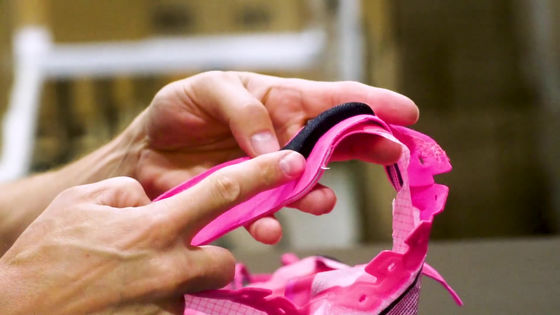
The shoe tongue is very thin.
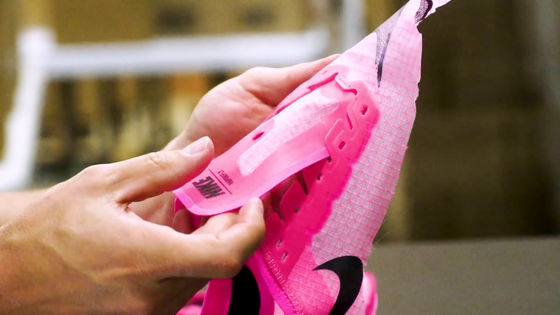
Peel off the top of the sole secured with adhesive.

This part is also the same as the general one.
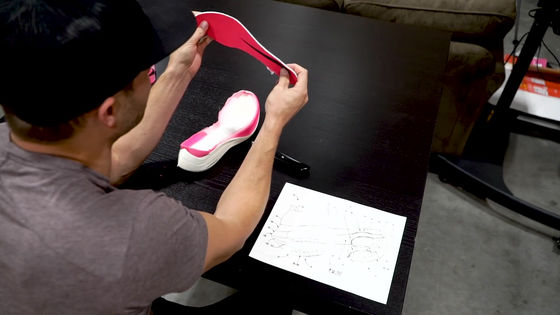
There is a stitch under the sole, so cut it with a cutter.
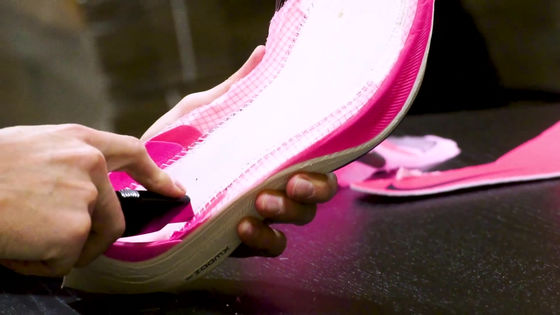
Then, a newly developed midsole called 'Zoom X Form' appeared. It seems to be a very cushioning material. Also, if you push this Zoom X form with bare hands, you can feel the presence of a carbon fiber plate in the back.
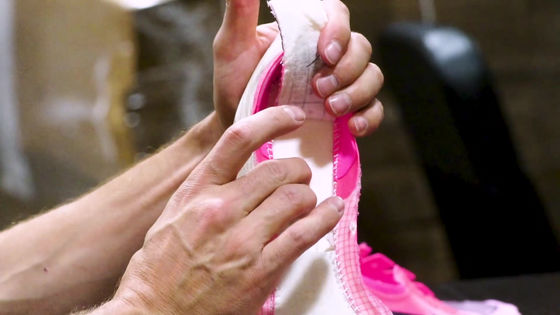
According to Simmons, the carbon fiber plate 'looks very thin, but is very durable and difficult to insert a cutter'. That's why I switched the cutter to a saw and cut 'Nike Zoom X Vapor Fly Next%' in two.
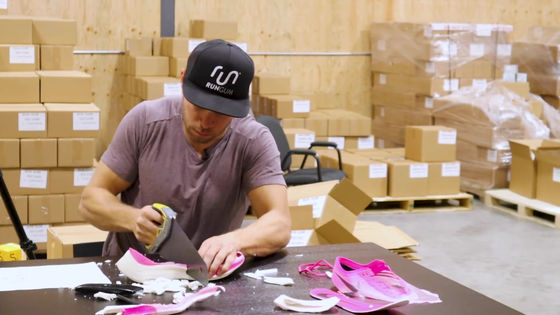
You can see that the black plate is sandwiched in the middle of the white sole. This is the carbon fiber plate that is the core of the high resilience of the Vapor Fly series.
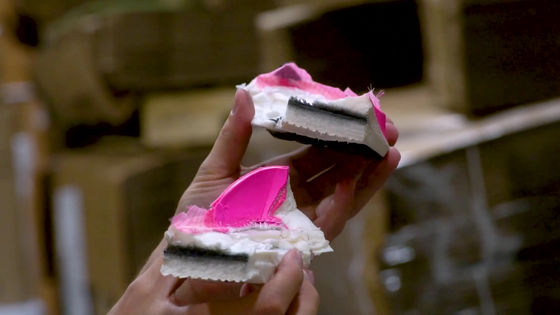
Simmons said, 'Nike's Nike Zoom X VaporFly next percent, given the extremely expensive carbon fiber used in shoes that are lightweight but sturdy and physically support the runner. There is no surprise at the $ 250 list price (30,250 yen including tax in Japan). '
In addition, the New York Times has statistically analyzed how the VaporFly series has affected runner performance, saying that it may have had a greater impact on runners than previously thought. Points out.
Nike's Fastest Shoes May Give Runners an Even Bigger Advantage Than We Thought-The New York Times
https://www.nytimes.com/interactive/2019/12/13/upshot/nike-vaporfly-next-percent-shoe-estimates.html

The New York Times has analyzed more than one million data from full and half marathons since 2014. There was no significant difference in the time between runners wearing 'Nike Vapor Fly 4%' and 'Nike Zoom X Vapor Fly Next%', so the two are collectively described as 'runner wearing vapor fly' doing.
The following graph summarizes the number of races analyzed by year. Most of the data is for races that took place in 2019.
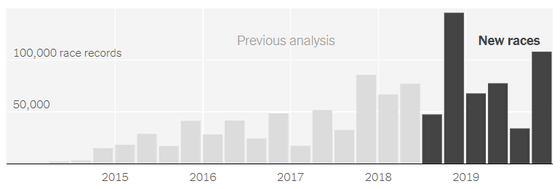
The New York Times stated, 'Similar (platform) shoes have been introduced to the market from other brands such as BROOKS, SAUCONY, New Balance, Hoka One One, and ASICS, and shoes with similar functions are planned to be released. These shoes may offer the same or even greater benefits as VaporFly, but in most cases there is not enough data to measure the effect. '
The VaporFly series came out in mid-2017, and since then many runners with particularly good times have worn the VaporFly series. In fact, in the last months of 2019, it has been found that about 41% of the best timekeepers who finish less than 3 hours in a full marathon are wearing the Vapor Fly series.
The following graph shows the percentage of excellent runners who wear the Vapor Fly series in less than 3 hours in a full marathon. 'First publicly available' in mid-2017 is when the VaporFly series is released to the general public. “Vaporfly” indicates “Nike Vapor Fly 4%” and “Next%” indicates “Nike Zoom X Vapor Fly Next%”.
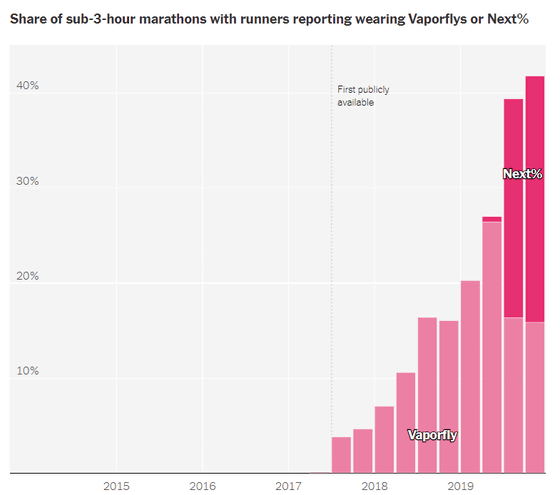
The following graph shows the results of using a statistical model to estimate how fast the time will be when the shoes worn during a marathon are replaced with the appropriate shoes. From slower to faster, Nike's VaporFly series is 'clearly out of reach with other popular shoes'. Other shoes only improve time by a factor of about 1-2% at best, but the Vaporfly series is estimated to improve time by just over 4%.
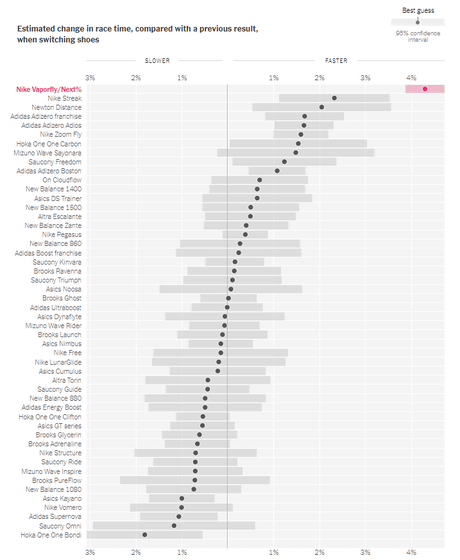
From the data of runners who participated in the same race twice or more, the following graph summarizes the 'time change when changing shoes' for each changed shoe. The difference between the VaporFly series and the non-VaporFly series is even more pronounced, with the VaporFly series successfully reducing time by about 5%.
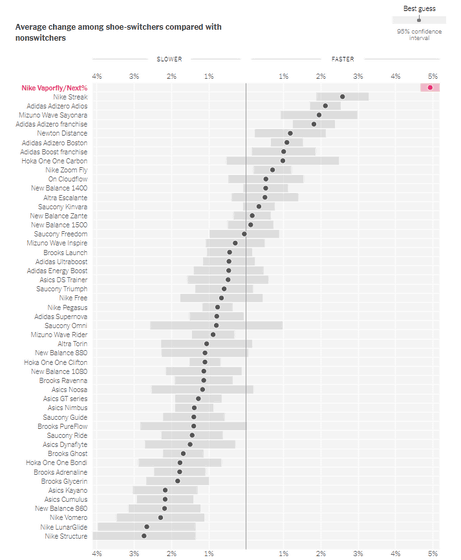
In addition, the following graph summarizes the change in time when changing to new shoes for each changed shoe. Even with this data, the time improvement ability of the Vapor Fly series is remarkable, recording a time improvement of about 5% that greatly separates other shoes.

The graph below summarizes the chances of updating your personal best when you change shoes. Other shoes seem to update their personal best with a probability of about 40 to 65%, but the Vapor Fly series seems to be able to update their personal best with a high probability of more than 70%.
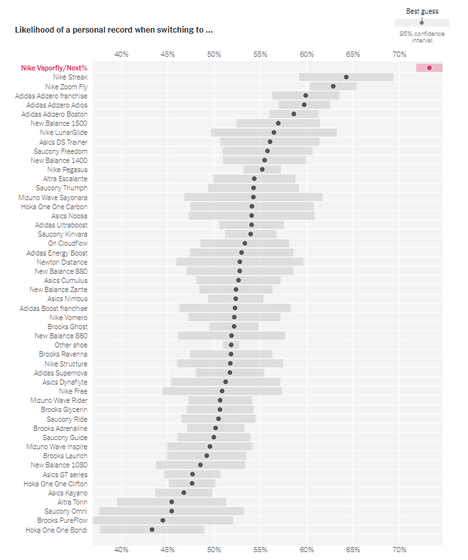
Marathon courses vary widely, with some rugged and flat. Difficulties also vary considerably depending on the timing of the race, and the temperature and weather greatly affect the race results. Considering the various factors that affect the time of these marathons, it is clear that the Vapor Fly series has played a major role in reducing runners' time.
As mentioned earlier, the difference between the VaporFly series and other shoes is the carbon fiber plate sandwiched between the midsole. The New York Times wrote about the plate, 'It acts as a slingshot or catapult to support the runner's propulsion, storing and releasing energy on each slide when running.'
The New York Times used data analysis for services such as Strava , an SNS for marathon runners. In this service, the race information, final time, and shoes worn by each user who participated are released, and the data from 570,000 full marathons and 496,000 half marathons only from 2014 to December 2019 are recorded I was able to collect.
Related Posts:
